 |
|
Here and There introduces art, artists, galleries and museums around Japan that non-Japanese readers and first-time visitors may find of particular interest. The writer claims no art expertise, just a subjective viewpoint acquired over many years' residence in Japan.
|
|
 |
|
|
 |
 |
Ainu Tales in Tapestries: Shizue Ukaji at the Philia Museum
Alan Gleason |
 |
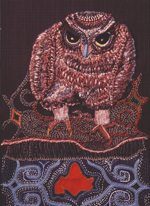 |
|
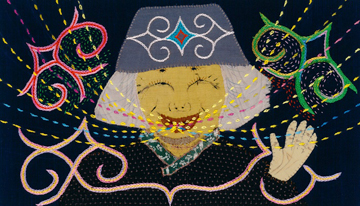 |
| Kamui Chikap Kamui, the owl god, above an Ainu pattern embracing the island of Hokkaido. Embroidery on fabric by Shizue Ukaji, 2008. |
|
An old woman sings out her warning of a tsunami. From The Song of the Cicada by Shizue Ukaji, published by Fukuinkan Shoten, 2008. |
The shimafukuro or island owl is a species of fish owl that dwells only on Japan's northernmost island of Hokkaido. With a wingspan that can reach two meters, it is the largest owl in the world. To the Ainu, the indigenous people of Hokkaido, the shimafukuro is a god -- a guardian deity who figures in many of their legends.
It is a miracle that these orally transmitted tales can even be heard today. The campaign by the Japanese government to develop Hokkaido and make it a permanent part of Japan did not begin in earnest until after the Meiji Restoration of 1868, but in mere decades the native Ainu population and its culture were nearly eradicated. In the early 1970s, however, an Ainu rights movement emerged, demanding, among other things, that the government recognize the Ainu as an indigenous minority. The activists' efforts culminated in passage of the Ainu Cultural Law in 1997.
 |
|
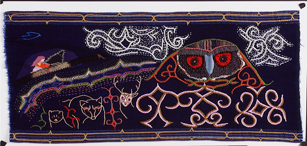 |
| The old woman is swept out to sea, but returns to land as a singing cicada. From The Song of the Cicada by Shizue Ukaji, published by Fukuinkan Shoten, 2008. |
|
The owl god watches over his little sister in a tapestry based on the Ainu legend Tokina-to. Embroidery on fabric by Shizue Ukaji, published in Tokina-to: Song by a Little Sister of the God Owl by Fukuinkan Shoten, 2008. |
One of the leaders of this movement was an Ainu poet named Shizue Ukaji. Born in Hokkaido in 1933, she moved at age 23 to Tokyo, one of many Ainu who migrated to the capital to escape the poverty and discrimination they faced in Hokkaido. In Tokyo Ukaji fought not only for Ainu rights and recognition, but also to preserve Ainu culture. In the 1990s she began to study traditional Ainu embroidery. Applying Ainu patterns and needlework to scraps of old kimono fabric, she invented her own distinctive medium of expression: kofu-e, or "old cloth pictures."
Ukaji places her art in the service of giving form to the ancient myths of the Ainu -- the oral tradition of epics known as yukara. Her pictures are like small tapestries, which she produces in series to tell a story. Humans, gods, and monsters figure prominently, but pride of place goes to animals of all sorts -- salmon, snakes, cicadas, and most notably, owls -- big owls, with piercing eyes. Her creatures fly, swim and crawl across the fabric in what seem like free-form improvisations of needlework, but they are anchored by the repetition of traditional Ainu patterns: wave- or cloud-like curls and spirals that remind one of the totem pole motifs of indigenous people on the other side of the ocean, in the Pacific Northwest.
It makes sense that Ukaji's kofu-e would be compiled into picture books, a literary medium that has achieved something of an artistic zenith in Japan. In just the last five years the venerable children's publisher Fukuinkan has produced three beautiful books of Ukaji's art, each volume telling one of the yukara legends.
And it makes equally good sense to display these pictures in narrative sequence on the walls of an art museum. This is what the Philia Museum in Yamanashi Prefecture has done, and one cannot imagine a more sympatico environment for Ukaji's work.
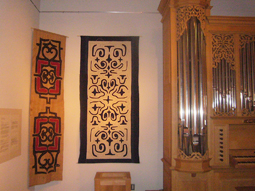 |
|
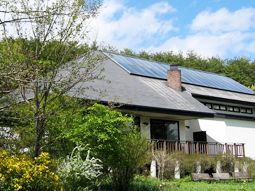 |
Two tapestries of traditional Ainu patterns by Shizue Ukaji hang next to the pipe organ in the main gallery of the Philia Museum. Photo by Alan Gleason.
|
|
The pastoral setting of the Philia Museum, opened in 1990 in Kobuchizawa, Yamanashi Prefecture.
All images courtesy of the Philia Museum |
The Philia overlooks a broad alpine meadow on the lower slopes of Yatsugatake, a volcanic massif in the center of Japan's main island of Honshu. Beyond the meadow tower the snowy peaks of the Southern Alps. It is probably as close an approximation of Ukaji's northern homeland as one is likely to find anywhere on Honshu.
The museum itself is also an excellent fit, albeit in unexpected ways. The Philia has nothing remotely "ethnic," artsy-craftsy, or even traditionally Japanese about it. In fact, it resembles a medieval European chapel, complete with high wooden rafters and a pipe organ in the main gallery. This cloister-like ambience resonates most serendipitously with the tapestries, large and small, that make up Ukaji's exhibition. Two of her largest works, covered in geometric Ainu patterns, hang on the gallery wall next to the pipe organ: the juxtaposition is curious, but somehow perfect.
Along the other walls and in the mezzanine upstairs one can view, in sequence, the original embroidered-fabric pictures that illustrate three of Ukaji's picture books: The Owl God and a School of Salmon, The Song of the Cicada, and Tokina-to: Song by a Little Sister of the God Owl. By poignant coincidence, The Song of the Cicada tells the story of an old woman who warns the people in her fishing village of the imminent arrival of a tsunami, but to no avail.
An even more gut-wrenching association with Ukaji's work -- and life -- is provided by one of the museum's special collections in a room off the main gallery: a series of drawings by the Polish painter Mieczylaw Kosceilniak of life in Auschwitz, the Nazi death camp where he was imprisoned from 1941 to 1945. Viewing Kosceilniak's works in tandem with Ukaji's, it is impossible not to contemplate the parallels between the Holocaust and the fate of the Ainu, and their common origin in man's casual dehumanization of those perceived as Other. As tragedies continue to unfold to the north in Iwate, Miyagi and Fukushima, Ukaji and the Philia Museum offer us some timely perspectives, at once playful and sobering, on the caprices of the gods -- and on human hubris and folly.
Late spring is the perfect time to visit the Philia Museum and its bucolic environs. Ukaji's exhibition will be on view there until June 26.
|
|
 |
Shizue Ukaji: Pictures from Old Fabric |
 |
28 April - 26 June 2011 |
 |
Philia Museum |
 |
3476-76 Kami-Sasao, Kobuchizawa-cho, Hokuto-shi, Yamanashi Prefecture
Phone: 0551-36-4221
Open 9:30-5:00 (10:00-4:00 November through April), closed Wednesdays
Transportation: 20-minute walk or 5 minutes by taxi from Kobuchizawa Station on the JR Chuo Line (2 hours from Tokyo by limited express)
|
 |
|
 |
|
|
 |
 |
Alan Gleason
Alan Gleason is a translator, editor and writer based in Tokyo, where he has lived for 25 years. In addition to writing about the Japanese art scene he has edited and translated works on Japanese theater (from kabuki to the avant-garde) and music (both traditional and contemporary). |
|
|
|
 |
|